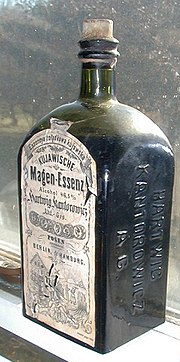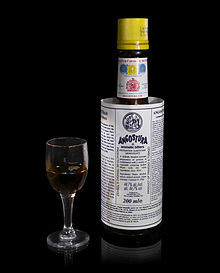Bitters

Abitters(plural alsobitters) is traditionally analcoholicpreparation flavored with botanical matter for abitteror bittersweetflavor.Originally, numerous longstanding brands of bitters were developed aspatent medicines,but now are sold asdigestifs,sometimes withherbalproperties, and ascocktailflavorings.
Since cocktails often contain sour and sweet flavors, bitters are used to engage anotherprimary tasteand thereby balance out the drink and make it more complex, giving it a more complete flavor profile.[1]
Ingredients
[edit]The botanical ingredients used historically in preparing bitters have consisted of aromatic herbs, bark, roots, and/or fruit for their flavor and medicinal properties. Some of the more common ingredients arecascarilla,cassia(Chinese cinnamon),gentian,orange peel,andcinchona bark.
Most bitters contain both water andalcohol,the latter of which functions as asolventfor botanical extracts as well as a preservative. The alcoholic strength of bitters varies widely across brands and styles. Some modern bitters are made with vegetableglycerin[2]instead, allowing those avoiding alcohol to enjoy them.
History
[edit]
The origins of bitters go back to the ancient Egyptians, who may have infused medicinal herbs in jars of wine.[3]This practice was further developed during theMiddle Ages,when the availability of distilled alcohol coincided with a renaissance inpharmacognosy,[4]which made possible more-concentrated herbal bitters and tonic preparations. Many of the brands and styles of digestive bitters today reflect herbal stomachic and tonic preparations whose roots are claimed to be traceable back toRenaissanceera pharmacopoeia and traditions.
By the nineteenth century, the British practice of adding herbal bitters (used as preventive medicines) toCanary winehad become immensely popular in the former American colonies.[5]By 1806, American publications referenced the popularity of a new preparation, termedcocktail,which was described as a combination of "a stimulating liquor, composed of spirits of any kind, sugar, water, and bitters".[6]
Of the commercial aromatic bitters that would emerge from this period, perhaps the best known isAngostura bitters.In spite of its name, the preparation contains no medicinal bark from theangosturatree; instead, it is named after the town of Angostura, present-dayCiudad Bolívar,in Venezuela. Eventually the factory was moved from Bolivar to Port of Spain, Trinidad in 1875. German physicianJohann Gottlieb Benjamin Siegerthad compounded a cure for sea sickness and stomach maladies, among other medicinal uses.[7]Siegert subsequently formed theHouse of Angosturato sell the bitters to sailors.
Another renowned aromatic bitters with nineteenth-century roots isPeychaud's Bitters,originally developed by apothecaryAntoine Amédée PeychaudinNew Orleans,Louisiana. It is most commonly associated with theSazerac cocktail.
A popular style of bitters that emerged from the period isorange bitters,the flavor of which ranges from dryly aromatic to fruity, and which is most commonly made from the rinds ofSeville orangesand spices. Orange bitters are commonly called for in older cocktail recipes. An early recipe for such bitters is inThe English and Australian Cookery Book:[8]"Make your own bitters as follows, and we can vouch for their superiority. One ounce and a half of gentian-root, one ounce and a half of lemon-peel, one ounce and a half of orange-peel. Steep these ingredients for about a month in a quart of sherry, and then strain and bottle for use. Bitters are a fine stomachic, but they must be used with caution."
Bitters prepared from the tree bark containing the antimalarialquinineoccasionally were included in historical cocktail recipes. It masked the medicine's intensely bitter flavor. Trace quantities of quinine are still included as a flavoring intonic water,which is used today mostly in drinks withgin.
Pioneering mixologistJerry Thomaswas largely responsible for an increase in the popularity of bitters in the United States when he releasedHow to Mix Drinks or The Bon-Vivant's Companionin 1862.[9][10]
Digestive bitters
[edit]Digestive bitters are typically consumed in many European and South American countries eitherneatoron the rocksat the end of a meal. Many, including popular Italian-styleamarosand German-styleKräuterlikörs,are often used in cocktails as well.
Some notable examples of modern digestive bitters include:
- Alomo Bitters(Ghana, Nigeria)
- Amaro Averna(Caltanissetta, Italy)
- Amaro Lucano(Pisticci, Italy)
- Amaro Montenegro(Bologna, Italy)
- Amaro Ramazzotti(Asti, Italy)
- Amaro Sibilla(Marche, Italy)
- Aperol(Padova, Italy)
- Balsam(Eastern Europe)
- Becherovka(Czech Republic)
- Beerenburg(Netherlands)
- Blutwurz(Bavaria)
- Braulio(Valtellina, Italy)
- Calisaya(United States)
- Campari(Novara-Milan, Italy)
- Cynar(Padova-Milan, Italy)
- Fernet-Branca(Milan, Italy)
- Fernet Stock(Italy-Czech Republic)
- Gammel Dansk(Denmark)
- Gran Classico Bitter(Switzerland)
- Hesperidina(Argentina)
- Jägermeister(Germany)
- Jeppson's Malört(United States)
- Killepitsch(Düsseldorf, Germany)
- Kuemmerling(Germany)
- Pelinkovac(Balkans)
- Quinquina(France – originally from South America)
- Rabarbaro Zucca(Milan, Italy)
- Ratzeputz(Germany)
- Riga Black Balsam(Latvia)
- St. Vitus(Germany)
- Schierker Feuerstein(Germany)
- Schwartzhog(Germany)
- Sirop de Picon(France)
- Suze(France)
- Tubi 60(Israel)
- Underberg(Germany)
- Unicum(Hungary)
- Wódka Żołądkowa Gorzka(Poland)
- Wurzelpeter(Germany)
Cocktail bitters
[edit]

Cocktail bitters are used for flavoring cocktails in drops or dashes. In the United States, many cocktail bitters are classified as alcoholic non-beverage products (non-beveragemeaning not consumed like a typical beverage). As alcoholic non-beverage products, they are often available from retailers who do not sell liquor, such as supermarkets in many US states.[citation needed]
Some notable examples of cocktail bitters include:[11]
- Angostura bitters– originally fromVenezuelain 1830, currently fromTrinidad and Tobago
- Boker's Bitters– called for in many cocktails in Jerry Thomas' drink guide,[12]and essential to theMartinezcocktail
- Meinhard's Bitters– a now-defunct bitter with Venezuelan origins
- Peychaud's Bitters– originally from New Orleans, Louisiana, but now produced inKentucky
See also
[edit]![]() Media related toBittersat Wikimedia Commons
Media related toBittersat Wikimedia Commons
- Flavored liquor– alcoholic beverage with added flavoring and, in most cases, added sugar
- Gentian (spirit)– alcoholic drink
- Purl– alcoholic beverage
- Shrub (drink)– fruit liqueur or vinegared syrup cordial
- Swedish bitters– traditional herbal tonic
References
[edit]- ^Hubbard, Lauren (February 14, 2022)."Everything You Need to Know About Bitters".Town & Country.
- ^McCarthy, Kelly (January 6, 2022)."No booze, no problem: How nonalcoholic drinks are shaking up the beverage industry".Good Morning America.
- ^"Ancient Remedy: Bitter Herbs and Sweet Wine".13 April 2009.Retrieved2013-11-03.
- ^"Medicinal Plants (History)".Retrieved2013-11-03.
- ^"A Brief History of Bitters".smithsonianmag.com. Archived fromthe originalon January 12, 2013.Retrieved2013-11-03.
- ^"Origin of the Cocktail".imbibemagazine.com. Archived fromthe originalon 2013-08-20.Retrieved2013-11-03.
- ^Hayes, Annie (2016-10-05)."Angostura: a brand history".The Spirit Business.The Spirit Business.Retrieved2019-11-29.
- ^Abbott, Edward (1864).The English and Australian Cookery Book.
- ^William Grimes,The Bartender Who Started It All,New York Times,October 31, 2007.
- ^"Uncorked: The bitter revolution".chicagotribune.com.Retrieved11 March2019.;"The Bitter Truth".imbibe.com.Archived fromthe originalon 15 March 2019.Retrieved11 March2019.
- ^"Ten Essential Bitters and How to Use Them".punchdrink.com.Archived fromthe originalon 19 March 2022.Retrieved11 March2019.
- ^"Cocktail History: Bogart's Bitters is a Recreation of a 150-Year-Old Recipe".themanual.com.5 February 2018.Retrieved11 March2019.
